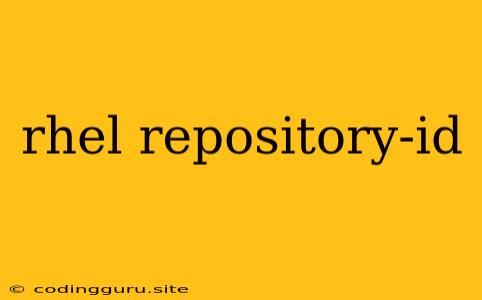Understanding RHEL Repository IDs: A Guide to Managing Your Red Hat Enterprise Linux System
Red Hat Enterprise Linux (RHEL) is a powerful and widely used operating system, offering a robust and secure platform for diverse applications. At the core of managing RHEL is the concept of repositories, which act as central locations for storing software packages, updates, and other system resources.
One crucial aspect of effectively managing RHEL repositories is understanding repository IDs. These IDs are unique identifiers that distinguish different repositories, enabling users to precisely target specific packages for installation or updates.
What is a Repository ID?
Think of a repository ID as an address for your RHEL system to find the specific software packages you need. Each repository holds a collection of packages, and the repository ID acts as a label to distinguish one repository from another. For instance, you might have a repository containing core system packages, another with development tools, and yet another with specific applications. Each of these repositories will have its own distinct repository ID.
Why Are Repository IDs Important?
Repository IDs are essential for several reasons:
- Precise Package Targeting: By using repository IDs, you can ensure that you are installing packages from the intended source, preventing unintended dependencies or compatibility issues.
- Efficient Package Management: Instead of relying on the default repositories, you can tailor your system's package sources by explicitly specifying the repository IDs for the specific packages you need.
- Security and Stability: By controlling which repositories your system accesses, you can enhance security and stability, minimizing the risk of installing outdated or potentially compromised packages.
Finding the Right Repository ID
Determining the appropriate repository ID for your specific needs can be crucial. Here are some common methods:
- Documentation: The official RHEL documentation provides detailed information about the various repositories and their corresponding repository IDs. Refer to the documentation for a comprehensive list.
yumCommand: Theyumpackage manager is a powerful tool for managing RHEL repositories. You can use theyum repolistcommand to list all available repositories along with their IDs.- Repository Configuration Files: The repository configuration files, usually located in
/etc/yum.repos.d/, provide insights into the defined repositories and their IDs. Examine these files for the desired repository ID.
Managing Repositories with Repository IDs
Once you know the repository IDs, you can effectively manage your RHEL system's package sources:
- Adding Repositories: Use the
yumcommand to add new repositories. Specify the repository ID along with the repository URL. - Removing Repositories: Use the
yumcommand to remove existing repositories. Specify the repository ID of the repository to remove. - Enabling and Disabling Repositories: Use the
yumcommand to enable or disable specific repositories. Specify the repository ID to control access to the repository.
Examples of Repository IDs
Here are a few examples of commonly encountered repository IDs in RHEL:
rhel-7-server-rpms: This repository ID typically represents the primary repository for RHEL 7 server packages.rhel-7-server-extras-rpms: This repository ID contains additional server packages not included in the primary repository.rhel-7-server-optional-rpms: This repository ID provides optional packages for RHEL 7 server installations.
Tips for Utilizing Repository IDs
- Maintain a List: Keep a record of the repository IDs you use to ensure consistency in managing your repositories.
- Prioritize Security: Choose repositories from trusted sources to enhance security.
- Regular Updates: Regularly update your RHEL system by updating the repositories and packages.
Conclusion
Understanding repository IDs is fundamental to effectively managing your RHEL system. By utilizing these identifiers, you can control the package sources, tailor your system's functionality, and enhance security and stability. Embrace the power of repository IDs to streamline your RHEL administration and ensure optimal system performance.
